Human Resource Management Practices Comparison: India vs UK
VerifiedAdded on 2020/02/03
|10
|2799
|42
Report
AI Summary
This report provides a comparative analysis of Human Resource Management (HRM) practices in India and the United Kingdom (UK). It begins by defining HRM and highlighting its significance in achieving organizational goals, including recruitment, selection, training, and performance appraisal. The report then examines how HRM practices vary across different countries, focusing on cultural, demographic, and regulatory factors. A detailed comparison of India and the UK follows, contrasting recruitment and selection processes, training and development programs, pay and benefits systems, and performance appraisal methods. The analysis highlights differences in organizational culture and management approaches. The report also discusses the problems faced by both countries in HRM, such as the impact of labor unions in the UK and the hierarchical structures in India. Finally, the report concludes by emphasizing the importance of HRM in fostering employee morale and productivity, and the need for organizations to adapt their practices to suit their specific contexts. The report is designed to help students understand the nuances of HRM in a global context.
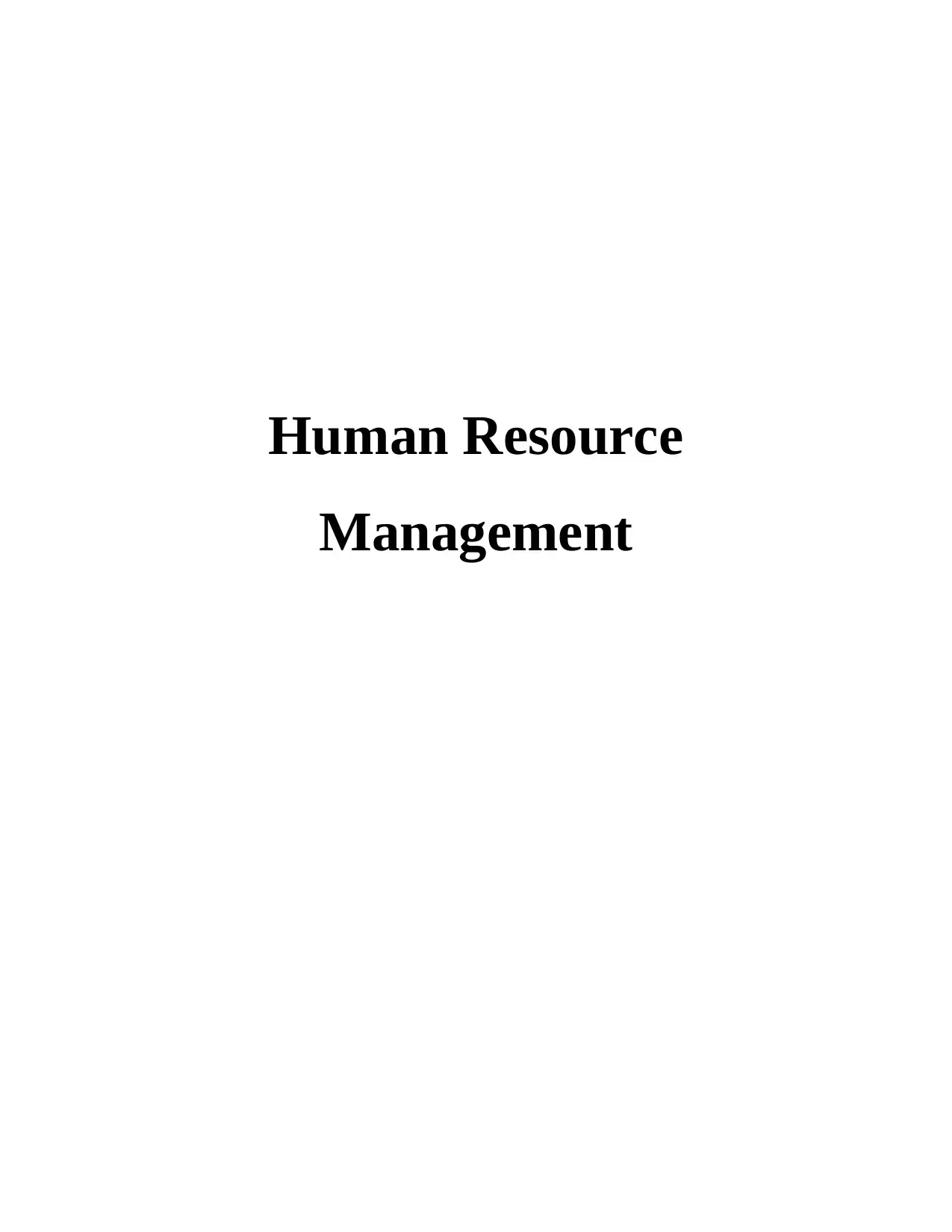
Human Resource
Management
Management
Paraphrase This Document
Need a fresh take? Get an instant paraphrase of this document with our AI Paraphraser
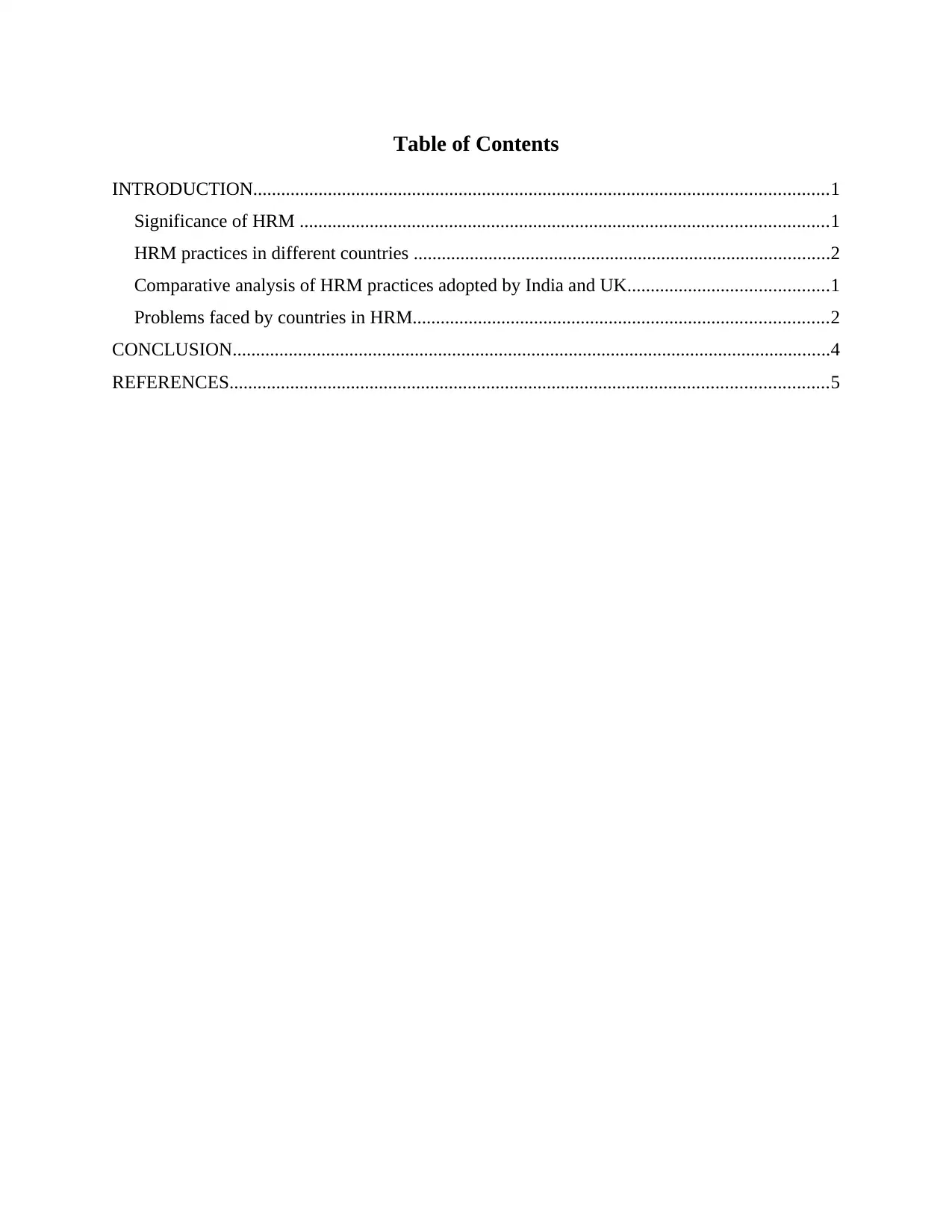
Table of Contents
INTRODUCTION...........................................................................................................................1
Significance of HRM .................................................................................................................1
HRM practices in different countries .........................................................................................2
Comparative analysis of HRM practices adopted by India and UK...........................................1
Problems faced by countries in HRM.........................................................................................2
CONCLUSION................................................................................................................................4
REFERENCES................................................................................................................................5
INTRODUCTION...........................................................................................................................1
Significance of HRM .................................................................................................................1
HRM practices in different countries .........................................................................................2
Comparative analysis of HRM practices adopted by India and UK...........................................1
Problems faced by countries in HRM.........................................................................................2
CONCLUSION................................................................................................................................4
REFERENCES................................................................................................................................5
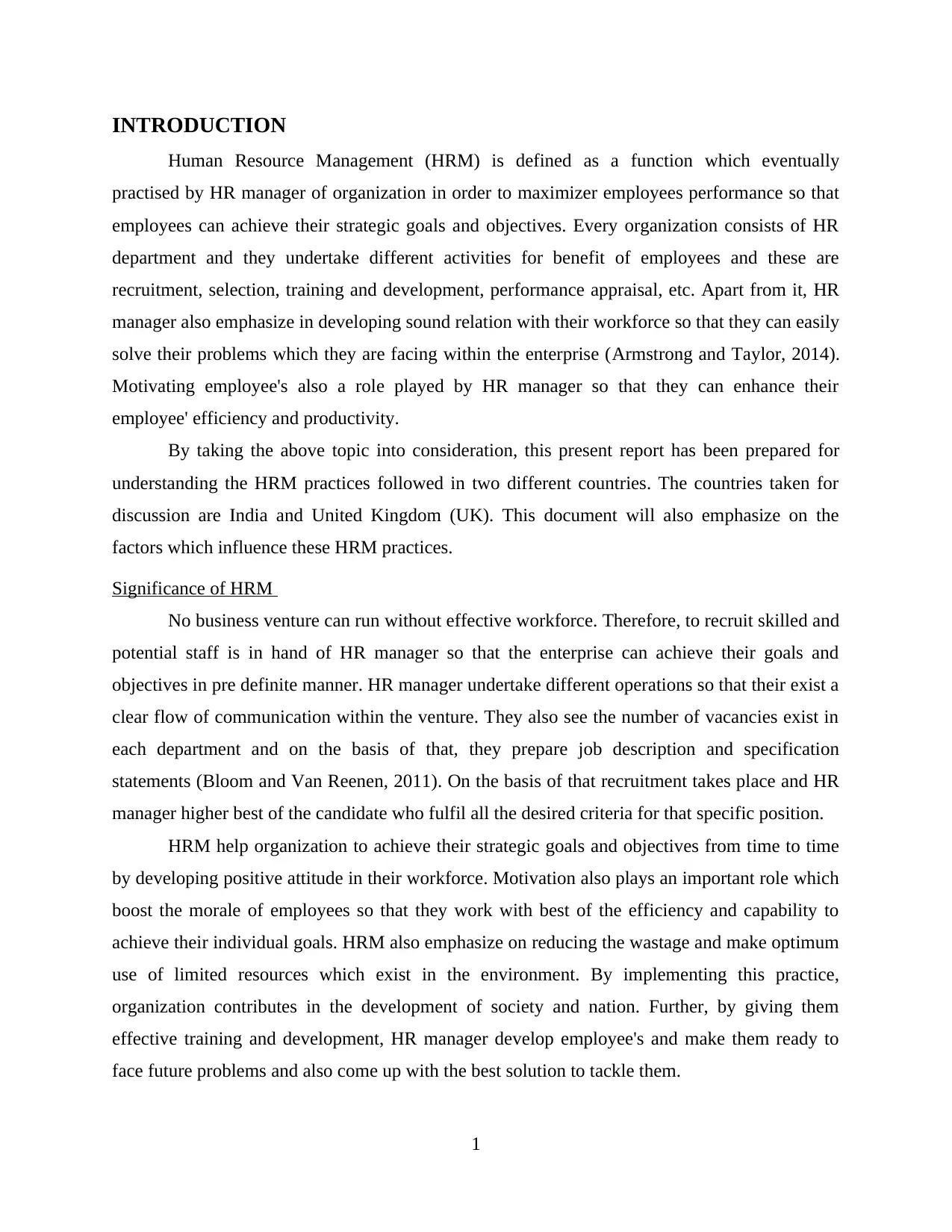
INTRODUCTION
Human Resource Management (HRM) is defined as a function which eventually
practised by HR manager of organization in order to maximizer employees performance so that
employees can achieve their strategic goals and objectives. Every organization consists of HR
department and they undertake different activities for benefit of employees and these are
recruitment, selection, training and development, performance appraisal, etc. Apart from it, HR
manager also emphasize in developing sound relation with their workforce so that they can easily
solve their problems which they are facing within the enterprise (Armstrong and Taylor, 2014).
Motivating employee's also a role played by HR manager so that they can enhance their
employee' efficiency and productivity.
By taking the above topic into consideration, this present report has been prepared for
understanding the HRM practices followed in two different countries. The countries taken for
discussion are India and United Kingdom (UK). This document will also emphasize on the
factors which influence these HRM practices.
Significance of HRM
No business venture can run without effective workforce. Therefore, to recruit skilled and
potential staff is in hand of HR manager so that the enterprise can achieve their goals and
objectives in pre definite manner. HR manager undertake different operations so that their exist a
clear flow of communication within the venture. They also see the number of vacancies exist in
each department and on the basis of that, they prepare job description and specification
statements (Bloom and Van Reenen, 2011). On the basis of that recruitment takes place and HR
manager higher best of the candidate who fulfil all the desired criteria for that specific position.
HRM help organization to achieve their strategic goals and objectives from time to time
by developing positive attitude in their workforce. Motivation also plays an important role which
boost the morale of employees so that they work with best of the efficiency and capability to
achieve their individual goals. HRM also emphasize on reducing the wastage and make optimum
use of limited resources which exist in the environment. By implementing this practice,
organization contributes in the development of society and nation. Further, by giving them
effective training and development, HR manager develop employee's and make them ready to
face future problems and also come up with the best solution to tackle them.
1
Human Resource Management (HRM) is defined as a function which eventually
practised by HR manager of organization in order to maximizer employees performance so that
employees can achieve their strategic goals and objectives. Every organization consists of HR
department and they undertake different activities for benefit of employees and these are
recruitment, selection, training and development, performance appraisal, etc. Apart from it, HR
manager also emphasize in developing sound relation with their workforce so that they can easily
solve their problems which they are facing within the enterprise (Armstrong and Taylor, 2014).
Motivating employee's also a role played by HR manager so that they can enhance their
employee' efficiency and productivity.
By taking the above topic into consideration, this present report has been prepared for
understanding the HRM practices followed in two different countries. The countries taken for
discussion are India and United Kingdom (UK). This document will also emphasize on the
factors which influence these HRM practices.
Significance of HRM
No business venture can run without effective workforce. Therefore, to recruit skilled and
potential staff is in hand of HR manager so that the enterprise can achieve their goals and
objectives in pre definite manner. HR manager undertake different operations so that their exist a
clear flow of communication within the venture. They also see the number of vacancies exist in
each department and on the basis of that, they prepare job description and specification
statements (Bloom and Van Reenen, 2011). On the basis of that recruitment takes place and HR
manager higher best of the candidate who fulfil all the desired criteria for that specific position.
HRM help organization to achieve their strategic goals and objectives from time to time
by developing positive attitude in their workforce. Motivation also plays an important role which
boost the morale of employees so that they work with best of the efficiency and capability to
achieve their individual goals. HRM also emphasize on reducing the wastage and make optimum
use of limited resources which exist in the environment. By implementing this practice,
organization contributes in the development of society and nation. Further, by giving them
effective training and development, HR manager develop employee's and make them ready to
face future problems and also come up with the best solution to tackle them.
1
⊘ This is a preview!⊘
Do you want full access?
Subscribe today to unlock all pages.

Trusted by 1+ million students worldwide
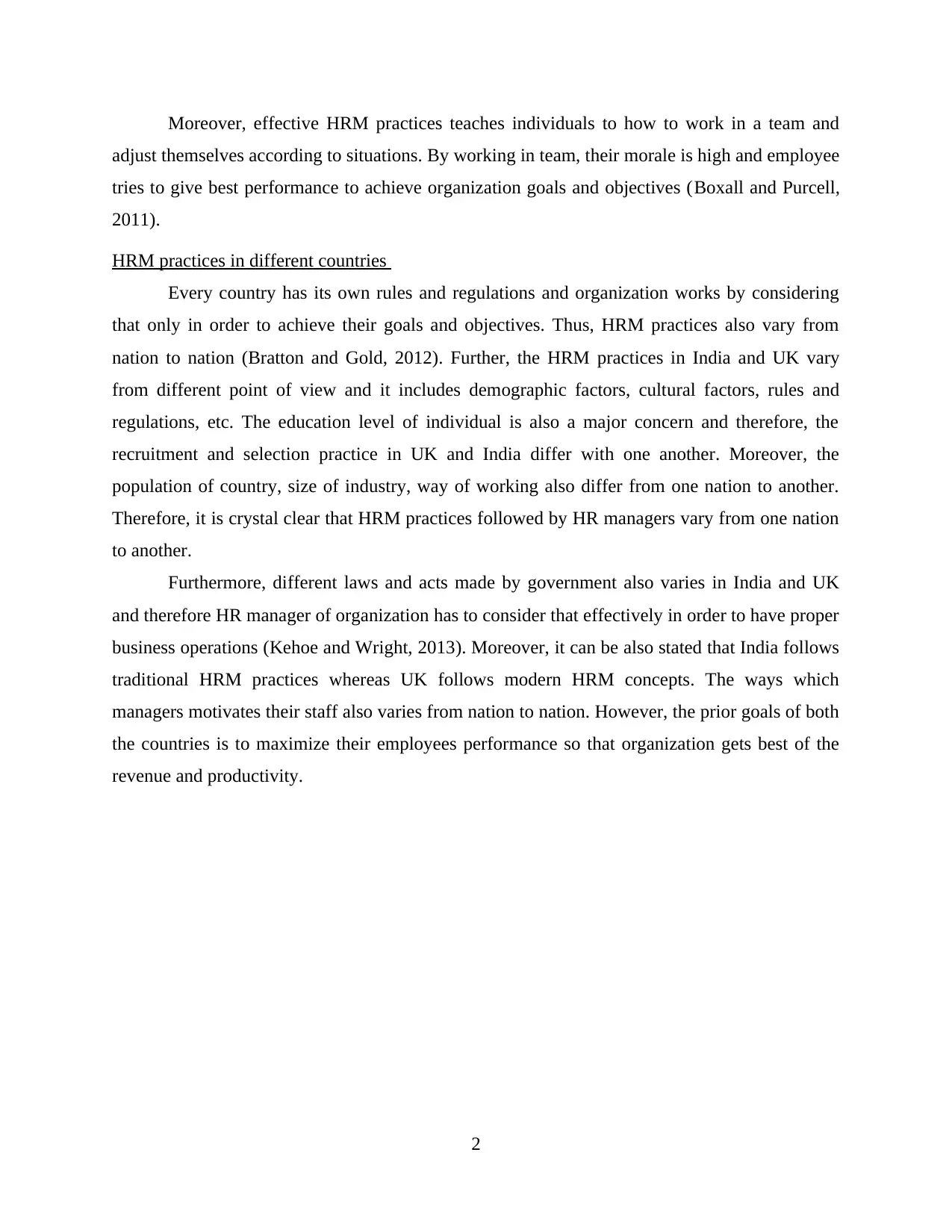
Moreover, effective HRM practices teaches individuals to how to work in a team and
adjust themselves according to situations. By working in team, their morale is high and employee
tries to give best performance to achieve organization goals and objectives (Boxall and Purcell,
2011).
HRM practices in different countries
Every country has its own rules and regulations and organization works by considering
that only in order to achieve their goals and objectives. Thus, HRM practices also vary from
nation to nation (Bratton and Gold, 2012). Further, the HRM practices in India and UK vary
from different point of view and it includes demographic factors, cultural factors, rules and
regulations, etc. The education level of individual is also a major concern and therefore, the
recruitment and selection practice in UK and India differ with one another. Moreover, the
population of country, size of industry, way of working also differ from one nation to another.
Therefore, it is crystal clear that HRM practices followed by HR managers vary from one nation
to another.
Furthermore, different laws and acts made by government also varies in India and UK
and therefore HR manager of organization has to consider that effectively in order to have proper
business operations (Kehoe and Wright, 2013). Moreover, it can be also stated that India follows
traditional HRM practices whereas UK follows modern HRM concepts. The ways which
managers motivates their staff also varies from nation to nation. However, the prior goals of both
the countries is to maximize their employees performance so that organization gets best of the
revenue and productivity.
2
adjust themselves according to situations. By working in team, their morale is high and employee
tries to give best performance to achieve organization goals and objectives (Boxall and Purcell,
2011).
HRM practices in different countries
Every country has its own rules and regulations and organization works by considering
that only in order to achieve their goals and objectives. Thus, HRM practices also vary from
nation to nation (Bratton and Gold, 2012). Further, the HRM practices in India and UK vary
from different point of view and it includes demographic factors, cultural factors, rules and
regulations, etc. The education level of individual is also a major concern and therefore, the
recruitment and selection practice in UK and India differ with one another. Moreover, the
population of country, size of industry, way of working also differ from one nation to another.
Therefore, it is crystal clear that HRM practices followed by HR managers vary from one nation
to another.
Furthermore, different laws and acts made by government also varies in India and UK
and therefore HR manager of organization has to consider that effectively in order to have proper
business operations (Kehoe and Wright, 2013). Moreover, it can be also stated that India follows
traditional HRM practices whereas UK follows modern HRM concepts. The ways which
managers motivates their staff also varies from nation to nation. However, the prior goals of both
the countries is to maximize their employees performance so that organization gets best of the
revenue and productivity.
2
Paraphrase This Document
Need a fresh take? Get an instant paraphrase of this document with our AI Paraphraser
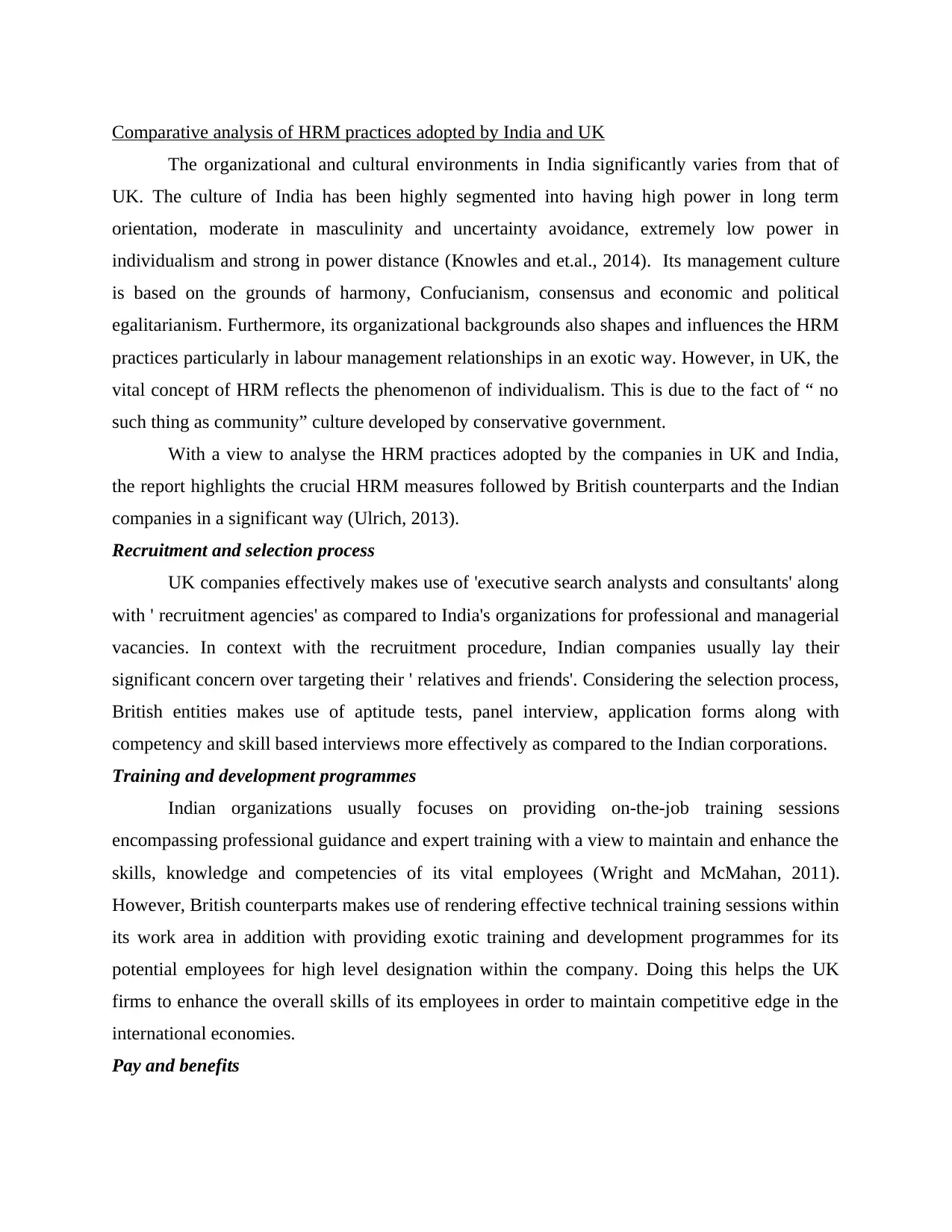
Comparative analysis of HRM practices adopted by India and UK
The organizational and cultural environments in India significantly varies from that of
UK. The culture of India has been highly segmented into having high power in long term
orientation, moderate in masculinity and uncertainty avoidance, extremely low power in
individualism and strong in power distance (Knowles and et.al., 2014). Its management culture
is based on the grounds of harmony, Confucianism, consensus and economic and political
egalitarianism. Furthermore, its organizational backgrounds also shapes and influences the HRM
practices particularly in labour management relationships in an exotic way. However, in UK, the
vital concept of HRM reflects the phenomenon of individualism. This is due to the fact of “ no
such thing as community” culture developed by conservative government.
With a view to analyse the HRM practices adopted by the companies in UK and India,
the report highlights the crucial HRM measures followed by British counterparts and the Indian
companies in a significant way (Ulrich, 2013).
Recruitment and selection process
UK companies effectively makes use of 'executive search analysts and consultants' along
with ' recruitment agencies' as compared to India's organizations for professional and managerial
vacancies. In context with the recruitment procedure, Indian companies usually lay their
significant concern over targeting their ' relatives and friends'. Considering the selection process,
British entities makes use of aptitude tests, panel interview, application forms along with
competency and skill based interviews more effectively as compared to the Indian corporations.
Training and development programmes
Indian organizations usually focuses on providing on-the-job training sessions
encompassing professional guidance and expert training with a view to maintain and enhance the
skills, knowledge and competencies of its vital employees (Wright and McMahan, 2011).
However, British counterparts makes use of rendering effective technical training sessions within
its work area in addition with providing exotic training and development programmes for its
potential employees for high level designation within the company. Doing this helps the UK
firms to enhance the overall skills of its employees in order to maintain competitive edge in the
international economies.
Pay and benefits
The organizational and cultural environments in India significantly varies from that of
UK. The culture of India has been highly segmented into having high power in long term
orientation, moderate in masculinity and uncertainty avoidance, extremely low power in
individualism and strong in power distance (Knowles and et.al., 2014). Its management culture
is based on the grounds of harmony, Confucianism, consensus and economic and political
egalitarianism. Furthermore, its organizational backgrounds also shapes and influences the HRM
practices particularly in labour management relationships in an exotic way. However, in UK, the
vital concept of HRM reflects the phenomenon of individualism. This is due to the fact of “ no
such thing as community” culture developed by conservative government.
With a view to analyse the HRM practices adopted by the companies in UK and India,
the report highlights the crucial HRM measures followed by British counterparts and the Indian
companies in a significant way (Ulrich, 2013).
Recruitment and selection process
UK companies effectively makes use of 'executive search analysts and consultants' along
with ' recruitment agencies' as compared to India's organizations for professional and managerial
vacancies. In context with the recruitment procedure, Indian companies usually lay their
significant concern over targeting their ' relatives and friends'. Considering the selection process,
British entities makes use of aptitude tests, panel interview, application forms along with
competency and skill based interviews more effectively as compared to the Indian corporations.
Training and development programmes
Indian organizations usually focuses on providing on-the-job training sessions
encompassing professional guidance and expert training with a view to maintain and enhance the
skills, knowledge and competencies of its vital employees (Wright and McMahan, 2011).
However, British counterparts makes use of rendering effective technical training sessions within
its work area in addition with providing exotic training and development programmes for its
potential employees for high level designation within the company. Doing this helps the UK
firms to enhance the overall skills of its employees in order to maintain competitive edge in the
international economies.
Pay and benefits
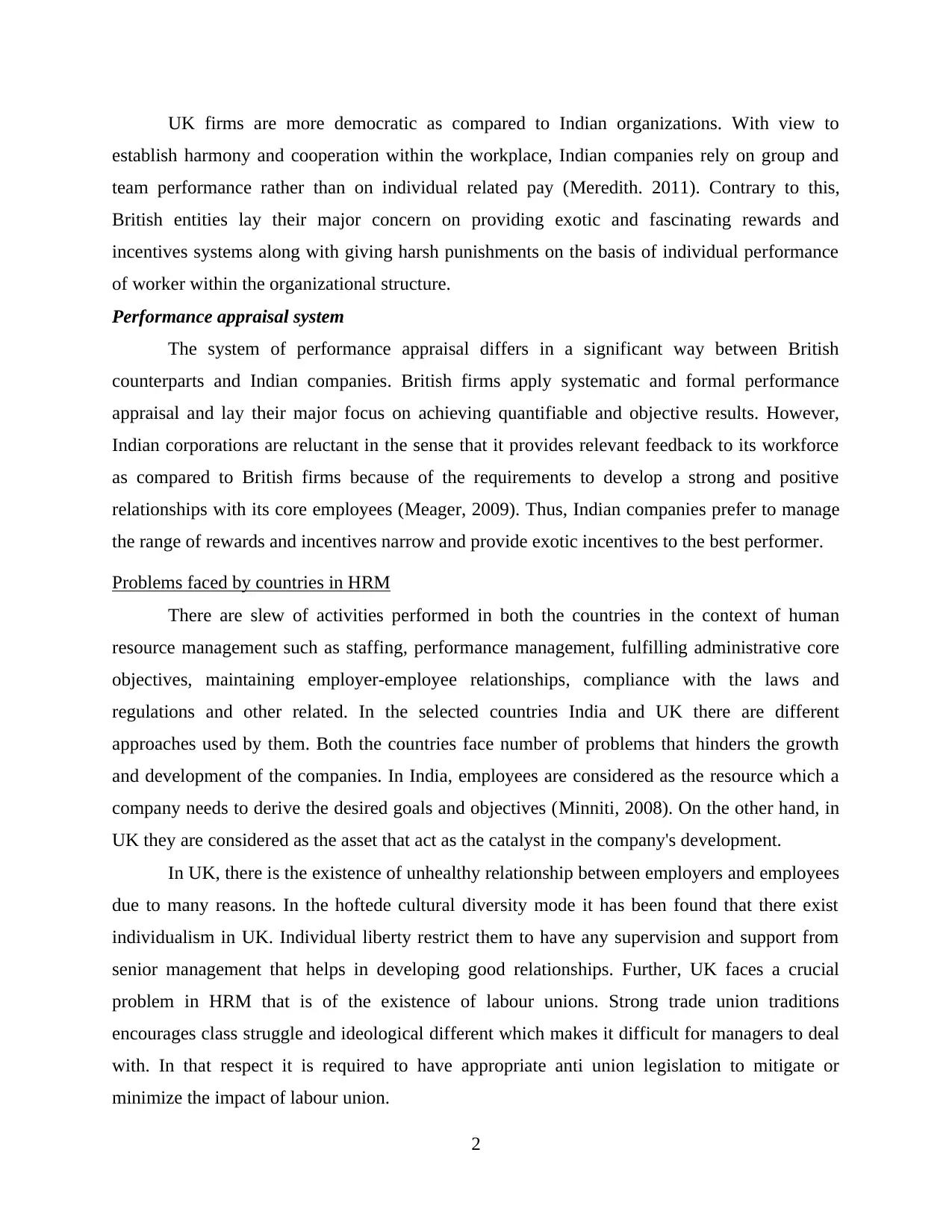
UK firms are more democratic as compared to Indian organizations. With view to
establish harmony and cooperation within the workplace, Indian companies rely on group and
team performance rather than on individual related pay (Meredith. 2011). Contrary to this,
British entities lay their major concern on providing exotic and fascinating rewards and
incentives systems along with giving harsh punishments on the basis of individual performance
of worker within the organizational structure.
Performance appraisal system
The system of performance appraisal differs in a significant way between British
counterparts and Indian companies. British firms apply systematic and formal performance
appraisal and lay their major focus on achieving quantifiable and objective results. However,
Indian corporations are reluctant in the sense that it provides relevant feedback to its workforce
as compared to British firms because of the requirements to develop a strong and positive
relationships with its core employees (Meager, 2009). Thus, Indian companies prefer to manage
the range of rewards and incentives narrow and provide exotic incentives to the best performer.
Problems faced by countries in HRM
There are slew of activities performed in both the countries in the context of human
resource management such as staffing, performance management, fulfilling administrative core
objectives, maintaining employer-employee relationships, compliance with the laws and
regulations and other related. In the selected countries India and UK there are different
approaches used by them. Both the countries face number of problems that hinders the growth
and development of the companies. In India, employees are considered as the resource which a
company needs to derive the desired goals and objectives (Minniti, 2008). On the other hand, in
UK they are considered as the asset that act as the catalyst in the company's development.
In UK, there is the existence of unhealthy relationship between employers and employees
due to many reasons. In the hoftede cultural diversity mode it has been found that there exist
individualism in UK. Individual liberty restrict them to have any supervision and support from
senior management that helps in developing good relationships. Further, UK faces a crucial
problem in HRM that is of the existence of labour unions. Strong trade union traditions
encourages class struggle and ideological different which makes it difficult for managers to deal
with. In that respect it is required to have appropriate anti union legislation to mitigate or
minimize the impact of labour union.
2
establish harmony and cooperation within the workplace, Indian companies rely on group and
team performance rather than on individual related pay (Meredith. 2011). Contrary to this,
British entities lay their major concern on providing exotic and fascinating rewards and
incentives systems along with giving harsh punishments on the basis of individual performance
of worker within the organizational structure.
Performance appraisal system
The system of performance appraisal differs in a significant way between British
counterparts and Indian companies. British firms apply systematic and formal performance
appraisal and lay their major focus on achieving quantifiable and objective results. However,
Indian corporations are reluctant in the sense that it provides relevant feedback to its workforce
as compared to British firms because of the requirements to develop a strong and positive
relationships with its core employees (Meager, 2009). Thus, Indian companies prefer to manage
the range of rewards and incentives narrow and provide exotic incentives to the best performer.
Problems faced by countries in HRM
There are slew of activities performed in both the countries in the context of human
resource management such as staffing, performance management, fulfilling administrative core
objectives, maintaining employer-employee relationships, compliance with the laws and
regulations and other related. In the selected countries India and UK there are different
approaches used by them. Both the countries face number of problems that hinders the growth
and development of the companies. In India, employees are considered as the resource which a
company needs to derive the desired goals and objectives (Minniti, 2008). On the other hand, in
UK they are considered as the asset that act as the catalyst in the company's development.
In UK, there is the existence of unhealthy relationship between employers and employees
due to many reasons. In the hoftede cultural diversity mode it has been found that there exist
individualism in UK. Individual liberty restrict them to have any supervision and support from
senior management that helps in developing good relationships. Further, UK faces a crucial
problem in HRM that is of the existence of labour unions. Strong trade union traditions
encourages class struggle and ideological different which makes it difficult for managers to deal
with. In that respect it is required to have appropriate anti union legislation to mitigate or
minimize the impact of labour union.
2
⊘ This is a preview!⊘
Do you want full access?
Subscribe today to unlock all pages.

Trusted by 1+ million students worldwide
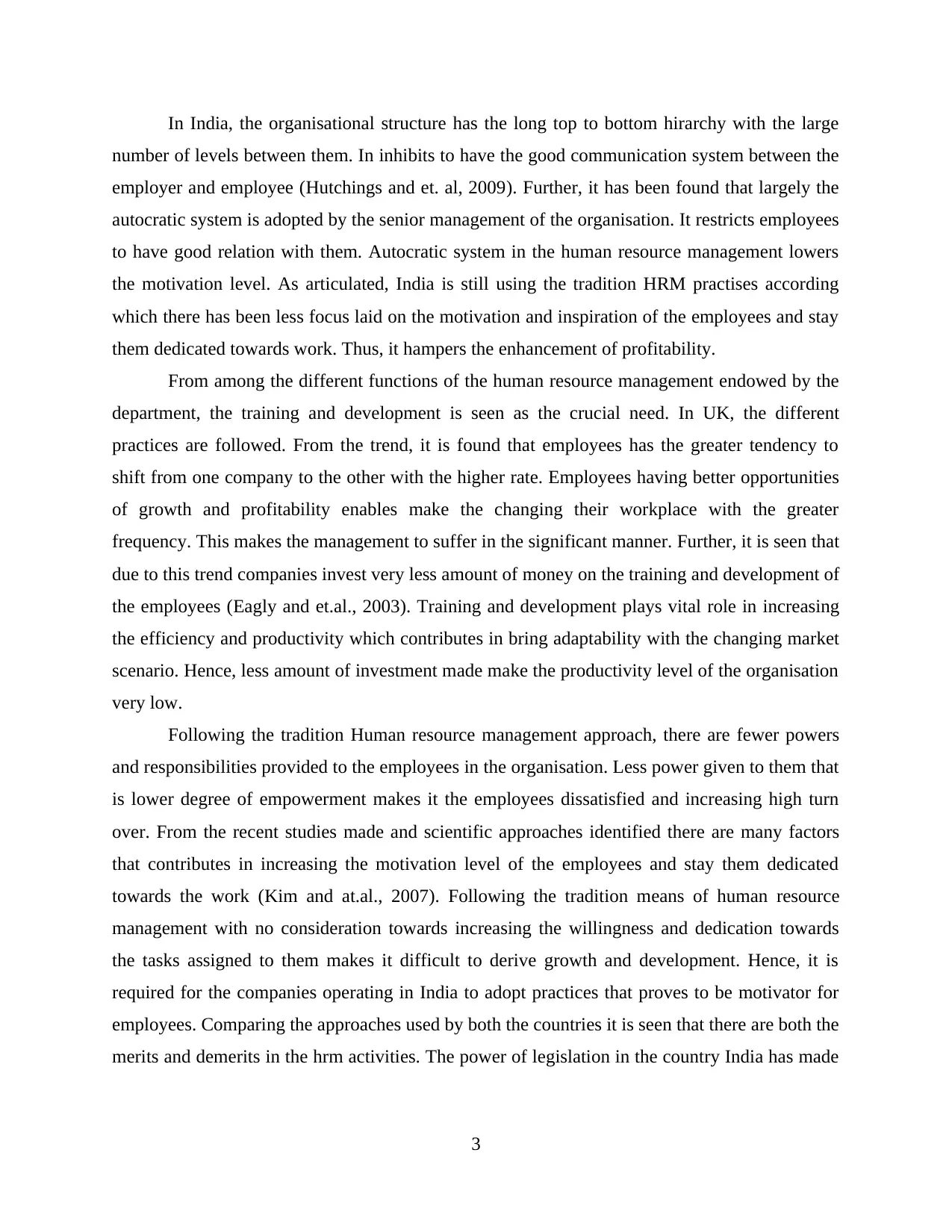
In India, the organisational structure has the long top to bottom hirarchy with the large
number of levels between them. In inhibits to have the good communication system between the
employer and employee (Hutchings and et. al, 2009). Further, it has been found that largely the
autocratic system is adopted by the senior management of the organisation. It restricts employees
to have good relation with them. Autocratic system in the human resource management lowers
the motivation level. As articulated, India is still using the tradition HRM practises according
which there has been less focus laid on the motivation and inspiration of the employees and stay
them dedicated towards work. Thus, it hampers the enhancement of profitability.
From among the different functions of the human resource management endowed by the
department, the training and development is seen as the crucial need. In UK, the different
practices are followed. From the trend, it is found that employees has the greater tendency to
shift from one company to the other with the higher rate. Employees having better opportunities
of growth and profitability enables make the changing their workplace with the greater
frequency. This makes the management to suffer in the significant manner. Further, it is seen that
due to this trend companies invest very less amount of money on the training and development of
the employees (Eagly and et.al., 2003). Training and development plays vital role in increasing
the efficiency and productivity which contributes in bring adaptability with the changing market
scenario. Hence, less amount of investment made make the productivity level of the organisation
very low.
Following the tradition Human resource management approach, there are fewer powers
and responsibilities provided to the employees in the organisation. Less power given to them that
is lower degree of empowerment makes it the employees dissatisfied and increasing high turn
over. From the recent studies made and scientific approaches identified there are many factors
that contributes in increasing the motivation level of the employees and stay them dedicated
towards the work (Kim and at.al., 2007). Following the tradition means of human resource
management with no consideration towards increasing the willingness and dedication towards
the tasks assigned to them makes it difficult to derive growth and development. Hence, it is
required for the companies operating in India to adopt practices that proves to be motivator for
employees. Comparing the approaches used by both the countries it is seen that there are both the
merits and demerits in the hrm activities. The power of legislation in the country India has made
3
number of levels between them. In inhibits to have the good communication system between the
employer and employee (Hutchings and et. al, 2009). Further, it has been found that largely the
autocratic system is adopted by the senior management of the organisation. It restricts employees
to have good relation with them. Autocratic system in the human resource management lowers
the motivation level. As articulated, India is still using the tradition HRM practises according
which there has been less focus laid on the motivation and inspiration of the employees and stay
them dedicated towards work. Thus, it hampers the enhancement of profitability.
From among the different functions of the human resource management endowed by the
department, the training and development is seen as the crucial need. In UK, the different
practices are followed. From the trend, it is found that employees has the greater tendency to
shift from one company to the other with the higher rate. Employees having better opportunities
of growth and profitability enables make the changing their workplace with the greater
frequency. This makes the management to suffer in the significant manner. Further, it is seen that
due to this trend companies invest very less amount of money on the training and development of
the employees (Eagly and et.al., 2003). Training and development plays vital role in increasing
the efficiency and productivity which contributes in bring adaptability with the changing market
scenario. Hence, less amount of investment made make the productivity level of the organisation
very low.
Following the tradition Human resource management approach, there are fewer powers
and responsibilities provided to the employees in the organisation. Less power given to them that
is lower degree of empowerment makes it the employees dissatisfied and increasing high turn
over. From the recent studies made and scientific approaches identified there are many factors
that contributes in increasing the motivation level of the employees and stay them dedicated
towards the work (Kim and at.al., 2007). Following the tradition means of human resource
management with no consideration towards increasing the willingness and dedication towards
the tasks assigned to them makes it difficult to derive growth and development. Hence, it is
required for the companies operating in India to adopt practices that proves to be motivator for
employees. Comparing the approaches used by both the countries it is seen that there are both the
merits and demerits in the hrm activities. The power of legislation in the country India has made
3
Paraphrase This Document
Need a fresh take? Get an instant paraphrase of this document with our AI Paraphraser
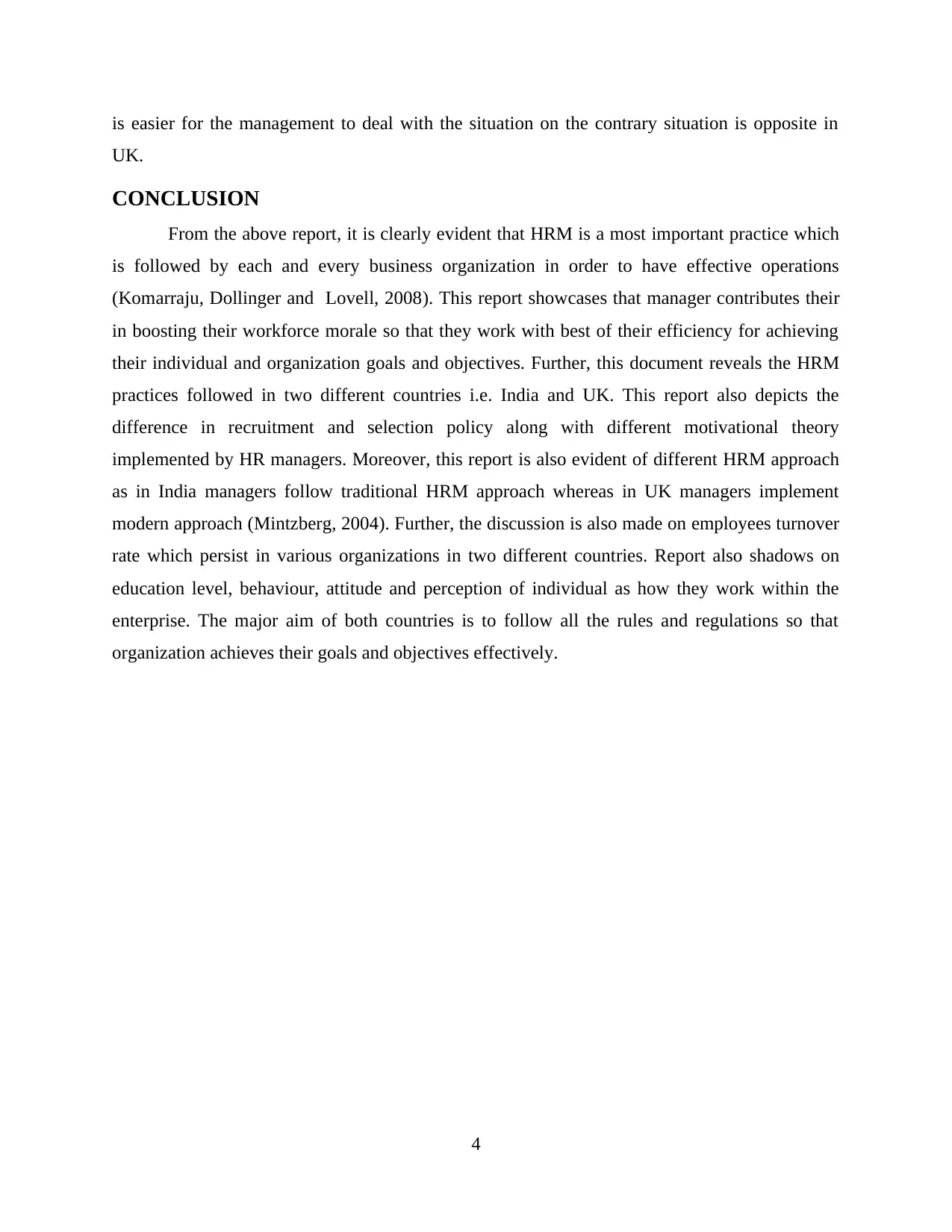
is easier for the management to deal with the situation on the contrary situation is opposite in
UK.
CONCLUSION
From the above report, it is clearly evident that HRM is a most important practice which
is followed by each and every business organization in order to have effective operations
(Komarraju, Dollinger and Lovell, 2008). This report showcases that manager contributes their
in boosting their workforce morale so that they work with best of their efficiency for achieving
their individual and organization goals and objectives. Further, this document reveals the HRM
practices followed in two different countries i.e. India and UK. This report also depicts the
difference in recruitment and selection policy along with different motivational theory
implemented by HR managers. Moreover, this report is also evident of different HRM approach
as in India managers follow traditional HRM approach whereas in UK managers implement
modern approach (Mintzberg, 2004). Further, the discussion is also made on employees turnover
rate which persist in various organizations in two different countries. Report also shadows on
education level, behaviour, attitude and perception of individual as how they work within the
enterprise. The major aim of both countries is to follow all the rules and regulations so that
organization achieves their goals and objectives effectively.
4
UK.
CONCLUSION
From the above report, it is clearly evident that HRM is a most important practice which
is followed by each and every business organization in order to have effective operations
(Komarraju, Dollinger and Lovell, 2008). This report showcases that manager contributes their
in boosting their workforce morale so that they work with best of their efficiency for achieving
their individual and organization goals and objectives. Further, this document reveals the HRM
practices followed in two different countries i.e. India and UK. This report also depicts the
difference in recruitment and selection policy along with different motivational theory
implemented by HR managers. Moreover, this report is also evident of different HRM approach
as in India managers follow traditional HRM approach whereas in UK managers implement
modern approach (Mintzberg, 2004). Further, the discussion is also made on employees turnover
rate which persist in various organizations in two different countries. Report also shadows on
education level, behaviour, attitude and perception of individual as how they work within the
enterprise. The major aim of both countries is to follow all the rules and regulations so that
organization achieves their goals and objectives effectively.
4
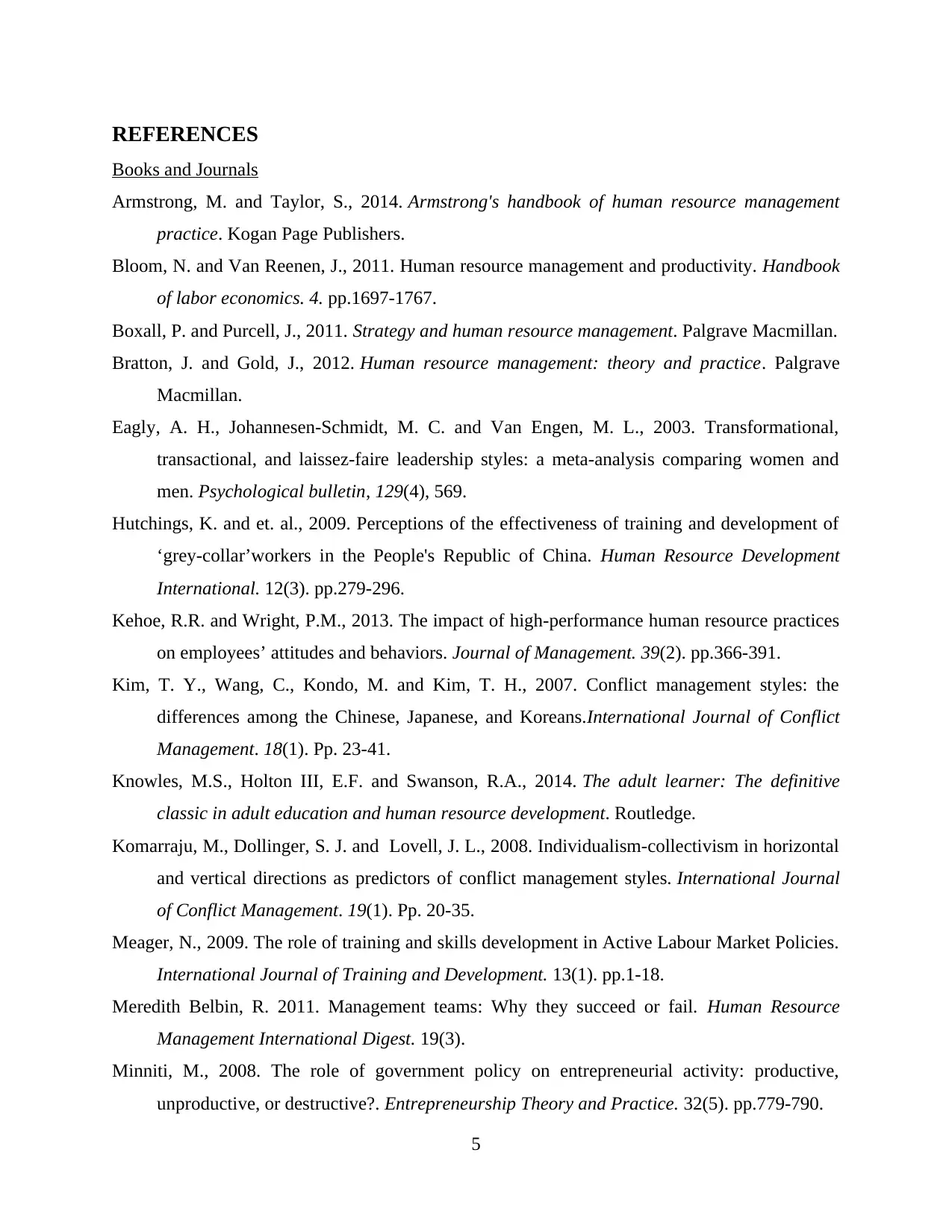
REFERENCES
Books and Journals
Armstrong, M. and Taylor, S., 2014. Armstrong's handbook of human resource management
practice. Kogan Page Publishers.
Bloom, N. and Van Reenen, J., 2011. Human resource management and productivity. Handbook
of labor economics. 4. pp.1697-1767.
Boxall, P. and Purcell, J., 2011. Strategy and human resource management. Palgrave Macmillan.
Bratton, J. and Gold, J., 2012. Human resource management: theory and practice. Palgrave
Macmillan.
Eagly, A. H., Johannesen-Schmidt, M. C. and Van Engen, M. L., 2003. Transformational,
transactional, and laissez-faire leadership styles: a meta-analysis comparing women and
men. Psychological bulletin, 129(4), 569.
Hutchings, K. and et. al., 2009. Perceptions of the effectiveness of training and development of
‘grey-collar’workers in the People's Republic of China. Human Resource Development
International. 12(3). pp.279-296.
Kehoe, R.R. and Wright, P.M., 2013. The impact of high-performance human resource practices
on employees’ attitudes and behaviors. Journal of Management. 39(2). pp.366-391.
Kim, T. Y., Wang, C., Kondo, M. and Kim, T. H., 2007. Conflict management styles: the
differences among the Chinese, Japanese, and Koreans.International Journal of Conflict
Management. 18(1). Pp. 23-41.
Knowles, M.S., Holton III, E.F. and Swanson, R.A., 2014. The adult learner: The definitive
classic in adult education and human resource development. Routledge.
Komarraju, M., Dollinger, S. J. and Lovell, J. L., 2008. Individualism-collectivism in horizontal
and vertical directions as predictors of conflict management styles. International Journal
of Conflict Management. 19(1). Pp. 20-35.
Meager, N., 2009. The role of training and skills development in Active Labour Market Policies.
International Journal of Training and Development. 13(1). pp.1-18.
Meredith Belbin, R. 2011. Management teams: Why they succeed or fail. Human Resource
Management International Digest. 19(3).
Minniti, M., 2008. The role of government policy on entrepreneurial activity: productive,
unproductive, or destructive?. Entrepreneurship Theory and Practice. 32(5). pp.779-790.
5
Books and Journals
Armstrong, M. and Taylor, S., 2014. Armstrong's handbook of human resource management
practice. Kogan Page Publishers.
Bloom, N. and Van Reenen, J., 2011. Human resource management and productivity. Handbook
of labor economics. 4. pp.1697-1767.
Boxall, P. and Purcell, J., 2011. Strategy and human resource management. Palgrave Macmillan.
Bratton, J. and Gold, J., 2012. Human resource management: theory and practice. Palgrave
Macmillan.
Eagly, A. H., Johannesen-Schmidt, M. C. and Van Engen, M. L., 2003. Transformational,
transactional, and laissez-faire leadership styles: a meta-analysis comparing women and
men. Psychological bulletin, 129(4), 569.
Hutchings, K. and et. al., 2009. Perceptions of the effectiveness of training and development of
‘grey-collar’workers in the People's Republic of China. Human Resource Development
International. 12(3). pp.279-296.
Kehoe, R.R. and Wright, P.M., 2013. The impact of high-performance human resource practices
on employees’ attitudes and behaviors. Journal of Management. 39(2). pp.366-391.
Kim, T. Y., Wang, C., Kondo, M. and Kim, T. H., 2007. Conflict management styles: the
differences among the Chinese, Japanese, and Koreans.International Journal of Conflict
Management. 18(1). Pp. 23-41.
Knowles, M.S., Holton III, E.F. and Swanson, R.A., 2014. The adult learner: The definitive
classic in adult education and human resource development. Routledge.
Komarraju, M., Dollinger, S. J. and Lovell, J. L., 2008. Individualism-collectivism in horizontal
and vertical directions as predictors of conflict management styles. International Journal
of Conflict Management. 19(1). Pp. 20-35.
Meager, N., 2009. The role of training and skills development in Active Labour Market Policies.
International Journal of Training and Development. 13(1). pp.1-18.
Meredith Belbin, R. 2011. Management teams: Why they succeed or fail. Human Resource
Management International Digest. 19(3).
Minniti, M., 2008. The role of government policy on entrepreneurial activity: productive,
unproductive, or destructive?. Entrepreneurship Theory and Practice. 32(5). pp.779-790.
5
⊘ This is a preview!⊘
Do you want full access?
Subscribe today to unlock all pages.

Trusted by 1+ million students worldwide
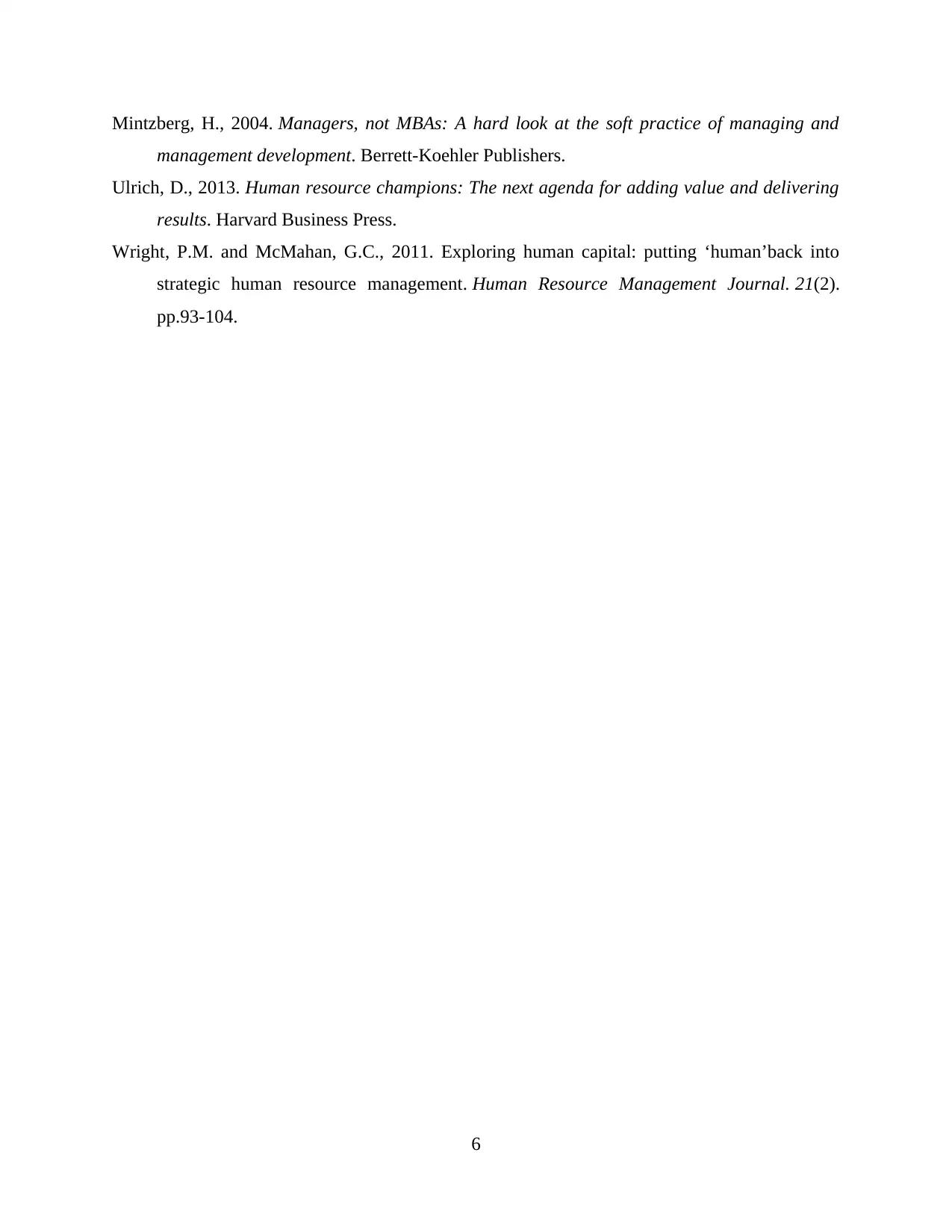
Mintzberg, H., 2004. Managers, not MBAs: A hard look at the soft practice of managing and
management development. Berrett-Koehler Publishers.
Ulrich, D., 2013. Human resource champions: The next agenda for adding value and delivering
results. Harvard Business Press.
Wright, P.M. and McMahan, G.C., 2011. Exploring human capital: putting ‘human’back into
strategic human resource management. Human Resource Management Journal. 21(2).
pp.93-104.
6
management development. Berrett-Koehler Publishers.
Ulrich, D., 2013. Human resource champions: The next agenda for adding value and delivering
results. Harvard Business Press.
Wright, P.M. and McMahan, G.C., 2011. Exploring human capital: putting ‘human’back into
strategic human resource management. Human Resource Management Journal. 21(2).
pp.93-104.
6
1 out of 10
Related Documents
Your All-in-One AI-Powered Toolkit for Academic Success.
+13062052269
info@desklib.com
Available 24*7 on WhatsApp / Email
![[object Object]](/_next/static/media/star-bottom.7253800d.svg)
Unlock your academic potential
Copyright © 2020–2025 A2Z Services. All Rights Reserved. Developed and managed by ZUCOL.




